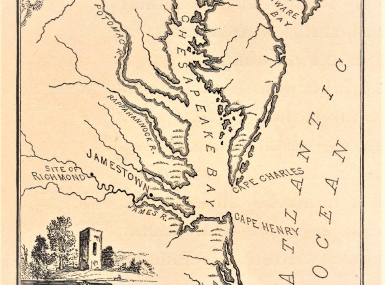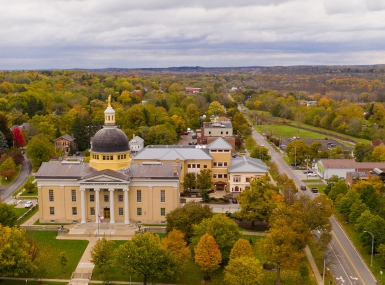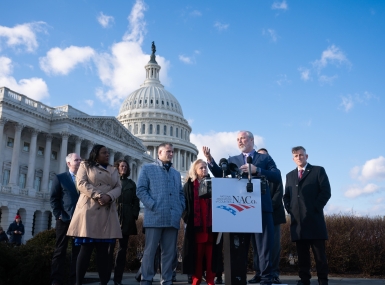What are counties?

Jump to Section
What exactly are counties? This question is the first step in learning about county governments and our collective impact on our communities and the lives of residents.
Counties are one of America’s oldest forms of government, dating back to 1634 when the first county governments (shires) were established along the eastern shores of Virginia. The organization and structure of today’s 3,069 county governments are chartered under state constitutions or laws and are tailored to fit the needs and characteristics of states and local areas.
County governments and our elected and appointed county leaders are instrumental partners in our nation’s intergovernmental system of federal, state, local and tribal officials. This system includes sub-state local compliance, delivery, management and implementation of federal laws, regulations, mandates and services.
This is the first of five modules in Counties 101. To explore what's next in Counties 101, click here.
The History of Counties
County governments trace our roots to the English shires of the 9th century. Rechristened “counties” after the Norman Invasion in 1066, they continued to serve a dual function — acting as administrative arms of the crown or national government as well as the citizens’ local government. Power in the shire/county was shared between the “shire-reeve,” or sheriff, and the justice of the peace.i
Counties evolved as units of local government and administration, but our importance from state to state and region to region varied depending on the economic, social and political conditions of the area.iii
Counties evolved as units of local government and administration, but our importance from state to state and region to region varied depending on the economic, social and political conditions of the area.iii
In 1790, census data reported 292 counties. As the nation continued its westward expansion, the same local government forms followed; as a result, the 19th century was the most active period of county formation in our nation’s history. The Northwest Ordinance allowed the newly settled territories to establish local governments and empowered the governors of those territories to create geographic divisions to serve as a unit of representation. As a result, between 1790 and 1900, over 2,000 counties were formed. Many of the less-settled portions of these states had a few very large counties in comparison to other states, which could then be subdivided as settlement expanded.iv And in some states, such as Texas, officials prioritized keeping local governments small so residents could be closer to the critical services that counties provide.v
After World War II, growth, suburban development and the government reform movement boosted the role of local governments. Those developments set the stage for post-World War II urbanization. In the 1970s and 1980s, a rise in the number of federal programs and unfunded federal mandates put pressure on counties to centralize our administrations and hire additional professional staff to guide operations.
The changes in structure, greater autonomy from the states, rising revenues and stronger political accountability ushered in a new era for county government. Counties began providing an ever-widening range of services. These trends continue today.
The U.S. Added Over 2,000 Counties in the 19th Century
What is a County?
A county is the primary legal division of most states for which the U.S. Census Bureau releases data – i.e., the geography of an area with county boundaries.
A county is the primary legal division of most states for which the U.S. Census Bureau releases data – i.e., the geography of an area with county boundaries. In Louisiana, a county is known as a parish. In Alaska, a county is known as a borough.
A county, as defined by the U.S. Census Bureau, may have a county government or may be considered a county equivalent for statistical purposes. Three thousand and sixty-nine (3,069) counties have county governments, which include 42 city-county consolidations, the District of Columbia and two independent cities (Baltimore City, Md. and St. Louis City, Mo.) considered county governments under their state constitution or city charter. For example, in Alaska some boroughs have city-borough consolidations or municipality-borough consolidations.
County Equivalents
The U.S. Census Bureau considers a county equivalent to be an unorganized area bearing county designations, an independent city or the District of Columbia. According to the U.S. Office of Management (OMB), there are 3,143 counties and county equivalents, for geographic reference and statistical purposes, in the United States.
- The state of Alaska and the S. Census Bureau created the Alaska census areas, which are unorganized areas and considered as counties for statistical purposes.
- The U.S. Census Bureau considers each of the five boroughs of New York City as counties for statistical purposes, but the boroughs no longer have their own county governments. New York City serves as a co solidated city-county government, with each borough maintaining its own municipality with limited government functions.
- The U.S. Census Bureau counts Kalawao County, Hawaii, as a county equivalent for statistical purposes, but the county does not have its own county government. Rather, Kalawao County is
a judicial district of Maui County’s government and is administered by the Hawaii Department of Health. The government of Maui County serves the islands of Maui, Moloka’i, Lana’i and Kaho’olawe. - All the counties in Connecticut and Rhode Island and seven county areas in Massachusetts no longer have county governments, so they are considered counties for statistical purposes only.vi Connecticut abolished all county governments in 1960 but still retained the former eight counties for elections and other administrative purposes, though the state transitioned to nine planning regions in 2024. Similarly, Rhode Island has counties that exist only for judicial administration purposes.vii Massachusetts, too, abolished 8 of its 14 county governments between 1997 and 2000, retaining county governments only in eastern Massachusetts with limited governmental functions.viii
- Four states states (Maryland, Missouri, Nevada and Virginia) have independent cities. The U.S. Census Bureau treats all independent cities as county equivalents for statistical purposes, but some have both municipality status and county government authority. For example, Baltimore City (Md.) and St. Louis City (Mo.) are considered county governments under their respective state constitutions and Carson City (Nev.) under its city charter. In contrast, the 38 independent cities in Virginia are designated only as incorporated areas under Virginia state law, meaning the cities are NOT within a county boundary.
What is a County Government?
Most often, a county government provides services to residents in both unincorporated and incorporated areas of the county.
A county government is an organized entity with governmental character which covers the area of a county or county equivalent. County governments have sufficient discretion in the management of our own affairs to be independent general purpose units of government. Depending on the state, county governments are also known as parish governments (in Louisiana) or borough governments (in Alaska).
Most often, a county government provides services to residents in both unincorporated and incorporated areas of the county. Incorporated areas of a county are governed by municipalities with their own government, having been established and organized as a municipal corporation as permitted under state law. Thus, residents in incorporated areas of a county receive municipal and county services. In contrast, unincorporated areas of a county do not have a municipal government and are not organized to provide any municipal services to residents in these areas.
NACo considers an entity to be a county government if it is recognized as a county government under the state constitution, state law or by charter. NACo refers to identifies 42 counties as “city-county consolidations” because they have both county and municipality authorities.
The number of county governments and county equivalents is not static; counties can change to meet the needs of local residents. The latest county established in the U.S. was the City and County of Broomfield, Colo., which formed in 2001, while Petersburg Borough, Alaska, was the latest county geography to incorporate and form a county government in 2013. County equivalents have seen even more recent changes: the Chugach and Copper River Census Areas in Alaska formed in 2019 (as statistical areas), and beginning in 2024, the Census formally recognized Connecticut’s nine planning regions, each with a council of governments, as county equivalents, in place of its eight historical county geographies.ix
About City-County Consolidations
NACo refers to these 42 counties as “city-county consolidations” because they have both county and municipality authorities. Most often, a city-county consolidation has a jail (not a temporary holding facility) and/or provides health care services for residents. Justice and public safety and health and hospitals are often top county investments.
Several of the nation’s largest U.S. cities are city-county consolidations, and many acquired this status more than a century ago. For example, the county governments of the NYC boroughs consolidated with the New York City government in 1898. As a result, New York City is a city-county consolidation which counts as one county government, but five county geographies for census statistical purposes.
Other large cities that are city-county consolidations include: New Orleans (consolidated with Orleans Parish in 1805), Boston (consolidated with Suffolk County in 1821), Philadelphia (consolidated with Philadelphia County in 1854), San Francisco (consolidated with San Francisco County in 1856) and Denver (consolidated with Denver County in 1902).
Alaska has the largest share of city-county consolidations (eight of the 19 boroughs). The latest city-county consolidation took place in 2014 in Georgia, between the city of Macon and Bibb County.
Alaska
- Anchorage Borough
- Haines Borough
- City and Borough of Juneau
- Petersburg Borough
- City and Borough of Sitka
- Skagway Borough
- City and Borough of Wrangell
- City and Borough of Yakutat
California
- San Fransisco City & County
Colorado
- Broomfield City and County
- Denver City and County
Florida
- Duval County/City of Jacksonville
Georgia
- Bibb County
- The Unified Government of Cusseta-Chattahoochee County
- Athens-Clarke County
- Echols County
- Columbus-Muscogee County
- Quitman County
- Augusta-Richmond County
- Webster County
Hawaii
- Honolulu City and County
Indiana
- Indianapolis and Marion County
Kansas
- Greely County
- Unified Govt. of Wyandotte County and Kansas City
Louisiana
- East Baton Rouge Parish
- Lafayette Consolidated Government
- Orleans Parish
- Terrebonne Parish Consolidated Government
Massachusetts
- Nantucket County
- Suffolk County, City of Boston
Montana
- Anaconda-Deer Lodge County
- Butte-Silver Bow County
Nevada
- Carson City
New Mexico
- Los Alamos County
New York
- New York City
North Carolina
- Camden County
Tennessee
- Metropolitan Government of Nashville and Davidson County
- Moore County
- Trousdale County
Counties by Population Size
Counties encompass a wide range of urban, suburban and rural areas throughout our jurisdictions. In place of a rural-urban classification,x NACo defines small counties as those with fewer than 50,000 residents, mid-sized counties as those between 50,000 and 500,000 residents, and large counties as those that have more than 500,000 residents.
The smallest county by population size is Loving County, Texas, with 43 residents, and the largest county by population is Los Angeles County, Calif., with nearly 10 million residents.xi California is one of 17 states where a majority of the population resides in large counties, while 14 states, including Alaska and North Dakota, do not have any large counties.xii
There are more very small counties with less than 20,000 residents (1,294 counties) than there are mid-sized or large counties with more than 50,000 residents (965 counties). Though there are only a small number of large counties, half of all county residents (162 million) live within one of these 136 counties. Los Angeles County, Calif. alone is home to 2 million more residents than the 1,000 smallest counties combined.
Over two-thirds of counties are small
Sixty-nine percent (2,104 counties) are small, while only 4 percent (136 counties) are large.
Explore County Data
Geographic Size
Alongside population size, county geographic size also varies significantly. The county government with the smallest geographic area is Arlington County, Va., at 26 square miles, and the county government with the largest geographic area in the lower 48 is San Bernardino County, Calif., at 20,105 square miles –larger than New Hampshire and Vermont combined. Alaska’s North Slope Borough is quadruple the size at 88,824 square miles, which would make it the 12th largest state.xiii
The disparities in terms of population and geographic size lead to very different population densities throughout America’s counties. Hudson County, N.J. has over 15,000 residents per square mile – comparable to major city-county consolidations like San Francisco City and County (17,000 residents/sq. mi.), Boston/Suffolk County (13,000 residents/sq. mi.) and Philadelphia City and County (12,000 residents/ sq. mi.). On the other hand, 20 counties across Alaska, Idaho, Montana, Nebraska, Nevada, New Mexico, South Dakota and Texas have less than 1 person every 2 square miles. Lake and Peninsula Borough, Alaska, has a population of 1,381 spread out over an area the size of West Virginia (nearly 24,000 square miles) – less than 1 resident for every 17 square miles.
Key Resources for this Section
NACo produces original research and civic engagement tools to tell the county story. Explore our tools that help answer the question "what are counties," designed to be used in your community.
For more resources about counties, explore our full suite of civic engagement tools here.

The County Landscape Project: A Primer on Our History, Definitions, Structures and Authorities
An in-depth look into the history of counties, our authority and structure, key county services and responsibilities and the intergovernmental partnership

Counties Matter: Stronger Counties. Stronger America.
Educate the public on the crucial role of counties with a national overview explaining key county functions

The County Landscape
A detailed look at the role of counties through the lens of national and county-level data

County Governance Project
A comprehensive guide to county government structure, authority, services and finances
Explore Counties 101
Each module is Counties 101 dives deep on a key facet how counties function, provide critical services and work with the other branches of government in our nation's system of federalism.

What are counties?
This question is the first step in learning about county governments and our collective impact on our communities and the lives of residents. Counties are one of America’s oldest forms of government, are key partners in our nation's system of federalism and provide critical services.

County structure, authority and finances
Counties are governed by locally elected officials, including more than 19,780 county elected executives and board members responsible for counties’ budgets, policies and oversight. In general, states authorize and set the roles and responsibilities of county governments. Explore how counties differ across the nation and how that affects the delivery of critical services to our residents.

County Roles & Responsibilities
All counties share the vision of achieving health, safe and vibrant counties across America. We are responsible for maintaining roads and bridges, caring for our physical and mental health, administering elections, ensuring public safety, strengthening environmental stewardship, and so much more.

Counties and the Intergovernmental Partnership
Counties are uniquely positioned to implement and administer vital intergovernmental systems, facilitate cooperation of all levels of government, and deliver results and impact for our residents and businesses at the community level.
Telling the County Story
Find tools to highlight the ways counties touch our everyday lives and act as key intergovernmental partners.

Counties Work Game & Curriculum
NACo, together with iCivics, has created a full curriculum to educate students, grades 6 through 12, about the important role and functions of county government. The curriculum and online game assist teachers with preparing lessons on county government.